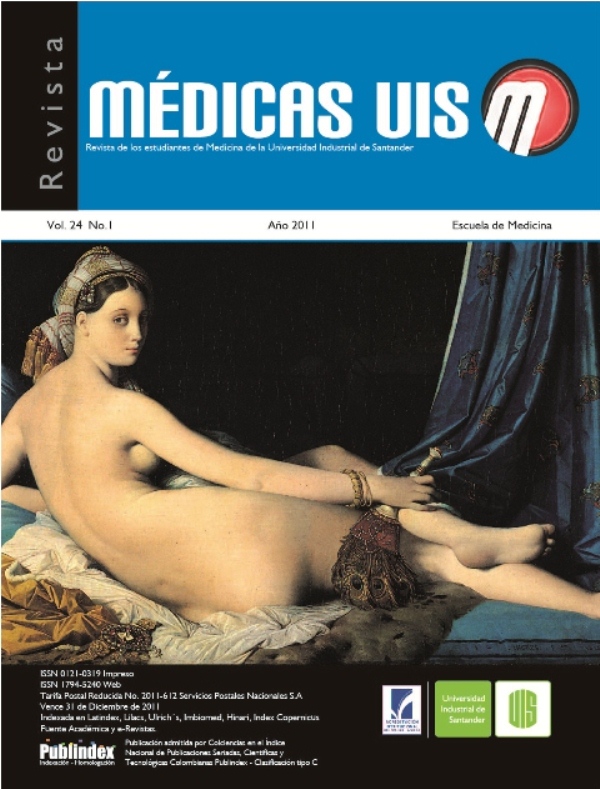Resumen
El consumo de comidas con alto contenido graso induce cambios agudos en los lípidos circulantes y disfunción endotelial horasdespués de la comida, condición que precede el desarrollo del proceso aterosclerótico. Aunque se desconoce exactamente elmecanismo responsable de la disminución de la función endotelial ocasionada por la lipemia posprandial, se considera que laelevación de las lipoproteínas ricas en triglicéridos, sus remanentes y un estado de estrés oxidativo, son los principalesmecanismos que determinan este hecho. Se presenta un reporte de dos adultos saludables de 30 años, a los cuales se lessuministró un menú que aportaba 1049 calorías, 31g de proteína, 79g de grasa (31g de grasa saturada), 666mg de colesterol y69g de carbohidratos, con el propósito de describir el efecto que induce la lipemia posprandial sobre la función endotelial, y surelación con algunos aspectos clínicos y bioquímicos asociados con este estado metabólico.
Palabras clave: Grasas en la Dieta. Vasodilatación. Endotelio. Periodo Post-prandial.
Referencias
2. Bots ML, Westerink J, Rabelink TJ, de Koning EJ. Assessment of flow-mediated vasodilatation (FMD) of the brachial artery: effects of technical aspects of the FMD measurement on the FMD response. Eur Heart J. 2005; 26:363-8.
3. Silva SY, Villamizar C, Villamizar N, Silva F, Luengas C, Casas JP, et al. Colombian study to assess the use of noninvasive determination of the endothelium-mediated vasodilation (CANDEV) II: does location of the occlusion device affects the accuracy of the diagnosis? Endothelium. 2005;12:107-11.
4. Vogel RA, Corretti MC, Plotnick GD. Effect of a single high-fat meal on endothelial function in healthy subjects. Am J Cardiol. 1997;79: 350–4.
5. Ross R. Atherosclerosis: An inflammatory disease. N Engl J Med. 1999;340:115-26.
6. Westphal S, Taneva E, Kastner S, Martens-Lobenhoffer S, Bode-Böger S, Kropf, J. Dierkes, et al. Endothelial dysfunction induced by postprandial lipemia is neutralized by addition of proteins to the fatty meal. Atherosclerosis. 2006;185:313-9.
7. Zilversmit DB. A proposal linking atherogenesis to the interaction of endothelial lipoprotein lipase with triglyceride-rich lipoproteins. Circ Res. 1997;33:633–8.
8. Hennig B, Alvarado A. Nutrition and endothelial cell integrity: Implications in atherosclerosis. Prog Food Nutr Sci. 1993;17:119-57.
9. Kusterer K, Pohl T, Fortmeyer HP, Marz W, Scharnagl H, Oldenburg A, et al. Chronic selective hypertriglyceridemia impairs endotheliumdependent vasodilatation in rats. Cardiovasc Res J. 1999;42:783-93.
10. Szabo C, Ischiropoulos H, Radi R. Peroxynitrite: biochemistry, pathophysiology and development of therapeutics. Nat Rev Drug Discov. 2007;6:662-80.
11. Kuzkaya N, Weissmann N, Harrison DG, Dikalov S. Interactions of peroxynitrite, tetrahydrobiopterin, ascorbic acid, and thiols: Implications for uncoupling endothelial nitric-oxide synthase. J Biol Chem. 2003;278:22546-54.
12. Cohn JS. Postprandial lipemia: emerging evidence for atherogenicity of remnant lipoproteins. Can J Cardiol. 1998;14(Suppl B):18B-27B.
13. Boquist S, Ruotolo G, Tang R, Bjorkegren J, Bond MG, de Faire U, et al. Alimentary lipemia, postprandial triglyceride-rich lipoproteins, and common carotid intima-media thickness in healthy, middle-aged men. Circulation. 1999;100:723-8.
14. de Gruijter M, Hoogerbrugge N, van Rijn MA, Koster JF, Sluiter W, Jongkind JF. Patients with combined hypercholesterolemia hypertriglyceridemia show an increased monocyte-endothelial cell adhesion in vitro: triglyceride level as a major determinant. Metabolism. 1991;40:1119-21.
15. Dart AM, Chin-Dusting JP. Lipids and the endothelium. Cardiovasc Res. 1999;3:308-22.
16. Doi H, Kugiyama K, Oka H, Sugiyama S, Ogata N, Koide SI, Nakamura SI, Yasue H. Remnant lipoproteins induce proatherothrombogenic molecules in endothelial cells through a redoxsensitive mechanism. Circulation. 2000;102:670-6.
17. de Koning EJ, Rabelink TJ. Endothelial function in the post-prandial state. Atheroscler Suppl. 2002;3:11-6.
18. Sodré FL, Paim BA, Urban A, Vercesi AE, Faria EC. Reduction in generation of reactive oxygen species and endothelial dysfunction during postprandial state. Nutr Metab Cardiovasc Dis. 2010 Jul 29.
19. Arcaro G, Cretti A, Balzano S, Lechi A, Muggeo M, Bonora E, Bonadonna RC. Insulin causes endothelial dysfunction in humans: sites and mechanisms. Circulation. 2002;105:576-82.
20. Magné J, Huneau JF, Delemasure S, Rochette L, Tomé D, Mariotti F. Whole-body basal nitric oxide production is impaired in postprandial endothelial dysfunction in healthy rats. Nitric Oxide. 2009;21:37-43.
21. Tsai WC, Li YH, Lin CC, Chao TH, Chen JH. Effects of oxidative stress on endothelial function after a high-fat meal. Clin Sci (Lond). 2004;106:315-19.
22. Kovacs I, Toldy E, Abel T, Tarjan J, Csaszar A. The effect of ciprofibrate on flow-mediated dilation and inflammatory markers in patients with combined hyperlipidemia. Endothelium. 2005;12:179-83.
